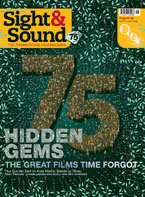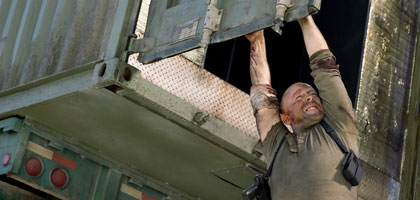
Die Hard 4.0
USA/UK 2007

Reviewed by Kim Newman
Synopsis
Our synopses give away the plot in full, including surprise twists.
US, the present. When computer criminals hack into government agencies, the FBI orders that the country's top hackers be brought in for questioning. NYPD officer John McClane is detailed to escort Matt Farrell, a young specialist in encrypted security systems. Assassins attempt to kill Matt at his apartment, but are thwarted by McClane. The FBI is distracted by an attack on Washington's traffic and communication systems. Matt realises that several fellow hackers have been murdered by a mystery man for whom they have all worked. Thomas Gabriel, an embittered ex-government computer specialist, is out to take over the computer systems that run essential services and utilities. Matt guesses that Gabriel's next move will be to take over a facility controlling the gas and power networks, McClane intervenes but Gabriel reroutes the gas mains and causes an explosion that knocks the power out anyway. McClane and Matt consult Warlock, a paranoid hacker who helps them figure out that the meltdown is designed to trigger a download to a secure facility backing up America's financial records. Gabriel plans to steal this information, supposedly to prove a point about the country's vulnerability to such attacks, but also to make an enormous amount of money. Though Gabriel kidnaps and threatens McClane's estranged daughter Lucy, McClane tracks down the villain's dwindling band of minions and, helped by Matt and Lucy, kills them all, saving the country.
Review
This latest Die Hard movie is undecided as to whether it is a reboot for its 1980s-spawned franchise or a last hurrah for shaven-headed, unbreakable Bruce Willis as an action hero. John McTiernan's original Die Hard (1988) was among the best suspense thrillers of its era, partly because it amped up the tension by playing its one-man-against-a-horde game within the strictly limited setting of a sealed-off skyscraper. Renny Harlin's Die Hard 2 (1990) and McTiernan's Die Hard With a Vengeance (1995) were forced to up the stakes at the expense of losing the claustrophobia - in these sequels, Willis' cop hero John McClane saved, respectively, an airport and the city of New York. Now, nothing less than endangering the entire eastern third of the United States will suffice to demand our attention. McClane has to pinball around several states and cities in one busy night, getting into computer-game-style shoot-outs and pursuits in each location, as all the other authorities in the country are distracted by sundry computer attacks while a determined band of bad guys plug away at an evil scheme well after the average minion would have up and quit.
The business of a franchise is to play variations on the format, and this ticks off almost all the Die Hard boxes - an imperilled relation (here, McClane's college-age daughter, played by young slasher-film vet Mary Elizabeth Winstead); a semi-unwilling sidekick (Justin Long of Jeepers Creepers cast as a sort of Jimmy Olsen tagalong); a suavely sinister mastermind at the end of a telephone (though Timothy Olyphant's humourless creep Gabriel never shows the acid edge that Alan Rickman or Jeremy Irons had in previous instalments); an array of unhelpful or impotent superior officers and experts, who always get in the way of the lone, street-level hero or show up just after he's done the job; a devious scheme that seems like terrorism but is actually pure larceny (ie: none of the controversy raised by the likes of True Lies or Executive Decision with their fictional jihads); product placement for hand-held forms of computer or phone tech (before 24, Die Hard was the mobile-phone thriller franchise); hordes of super-skilled but disposable minions, including a rubber-boned French killer and Maggie Q's svelte dragon lady; and an escalation from alarmingly credible action (a succession of fender-benders as all the traffic lights in a city turn green at once) to CGI-augmented absurdities (McClane in a truck taking on an F-111 fighter jet, and winning).
A decade on from the last sequel, there have to be some changes. This aims for a lower certification by minimising the number of bodies strewn around the landscape, tidying away much of the violence and even modifying McClane's catchphrase ("Yippie ky aye, motherfucker") so that he interrupts himself (by shooting through his own shoulder into a villain's heart) before he gets to the word that would earn an R rating in the States. In the earlier films, McClane's partners were black, but 4.0 replaces the race-relations angle with a generation gap, as McClane argues about music and computer jargon with Justin Long's Matt and has to reconnect with his daughter (who comes round pretty quick in a crisis).
Though it's mostly entertaining (if overlong), there is a sense that the whole thing has become somewhat rote. Len Wiseman, of the underwhelming Underworld franchise, directs efficiently but without much flair, stringing together set pieces that lack feeling. The earlier movies were powered by McClane's need to protect loved ones and by the antagonism between sham-polite villain and wittily abusive hero; both angles are played here, but feel tired. Even some of the most impressive perils seem borrowed - a scene with an SUV dangling in a lift shaft is a xerox from a sequence in The Lost World Jurassic Park,only with a kung-fu chick instead of a tyrannosaurus - and McClane's virtual invincibility becomes something of a joke, as he slides off a crashing fighter jet's wing on to a collapsing freeway and limps away to fight again.
Credits
- Directed by
- Len Wiseman
- Produced by
- Michael Fottrell
- Screenplay
- Mark Bomback
- Story
- Mark Bomback
- David Marconi
- Based upon the article A Farewell to Arms by John Carlin
- Certain original characters by Roderick Thorp
- Director of Photography
- Simon Duggan
- Film Editor
- Nicolas de Toth
- Production Designer
- Patrick Tatopoulos
- Music
- Marco Beltrami
